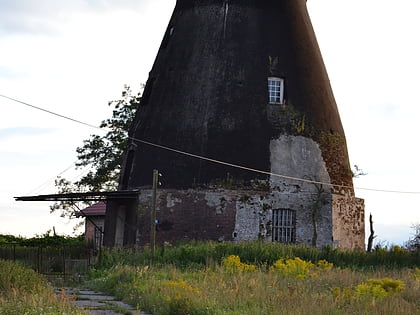Wzgórze Wisielców, Wolin


Facts and practical information
Wzgórze Wisielców - an archaeological reserve located south of Wolin on the hills above the Dziwna River with a barrow cemetery dating from the 9th to the 10th century.
The fenced barrow cemetery is located on the Dziwna River, on the hill called Gologóra.
The barrow burial site on Wysłielców Hill, site 9, belongs to the group of the oldest early-medieval necropolises in Western Pomerania. It is a unique archaeological site, still preserved in a legible way, which in the early Middle Ages constituted a vast settlement complex of Wolin. The dead were buried here in cremation and skeletal rites. The clearly visible birhitualism is interpreted as an expression of the influence of various cultural centers of Europe at that time: Scandinavian as well as Christian centers from Poland and Germany. However, some of the burials fall into the oldest phase, which is characterised exclusively by mortuary rites.
The existence of the necropolis on Wzgórze Wisielcow dates back to the period when there were barrow cemeteries in Pomerania with exclusively burial or birational rites. Originally, the graves had a circular shape. Their diameter ranged from 3 to 20 meters. During the research a barrow was discovered with a fence made of wooden stakes, which had been burnt before the grave was built. There were barrow and sub-burrow graves. The former were few in number. Burial graves occurred in the form of: ashlar, pit and layer graves. Some were surrounded by stones. Sometimes stones formed a paving under the layer of the pile.
The skeletal burials were at the level of the ground at the time, slightly sunken into the caliche, although most were reburied in barrows.
The dead were placed in wooden coffins. In skeletal burials the dead rested upright on their backs. Some barrows contained 2 or 3 burials.
The deceased were relatively poorly equipped. A characteristic feature of the Pomeranian necropolises is the richer equipment of women's graves. Among the inventories, ceramics were discovered, more rarely knives, whetstones, temple buckles and beads.
The name "Hill of Hanged Men" is later and is connected with the execution of pirates and criminals. The grave of a headless young man discovered at the highest point of the hill indicates that the sentence was carried out by beheading.
At the end of the 19th century, 93 barrows were counted on the hill, of which 34 graves remain.
There was an extensive settlement of the funnel-shaped cup and corded pottery culture here.
Wolin
Wzgórze Wisielców – popular in the area (distance from the attraction)
Nearby attractions include: Smock mill, Regional Museum, Skansen "Wioska Wikingów", Kościół pw. św. Stanisława.





